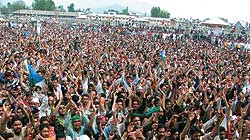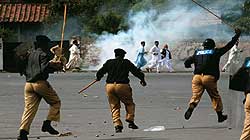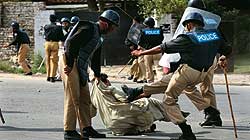Sixty one years is a long time. In that time, since the midnight of August 15, 1947, India’s population swelled from 345 million to nearly 1,200 million. From just over a couple of hundred thousand in 1947, we have more vehicles today than the entire human population of Canada. In that time, Amitabh Bachchan has served us countless hits on the silver screen, and cricketers like Sunil Gavaskar and Kapil Dev have debuted, entertained and retired. We have turned into the software capital of the world, and also the globe’s biggest back office. We have more English speaking people than any other country, except the United States. For a Hindu nation that truly practices secularism, we’ve had four Muslim Presidents, three Muslim Chief Justices, four Muslim cricket captains, and at least half a dozen Muslim Bollywood superstars over the years.
 In those 61 years, we’ve also fought three wars with Pakistan, our Parliament and Red Fort have been attacked by terrorists from that country. We’ve witnessed a trail of blood, bullets, grenades and smoke that have claimed over a 100,000 lives. We’ve seen the scourge of terrorism cut across the fabric of our society. Billions of dollars have been spent trying to save Kashmir, to keep terror at bay, and to keep Indian pride alive. Tireless efforts have been made to broker peace with Pakistan by opening up bus and rail routes, sending Bollywood stars and legendary singers across the Wagah, playing more cricket matches, and allowing our neighbour to do the same. In those 61 years, we’ve also fought three wars with Pakistan, our Parliament and Red Fort have been attacked by terrorists from that country. We’ve witnessed a trail of blood, bullets, grenades and smoke that have claimed over a 100,000 lives. We’ve seen the scourge of terrorism cut across the fabric of our society. Billions of dollars have been spent trying to save Kashmir, to keep terror at bay, and to keep Indian pride alive. Tireless efforts have been made to broker peace with Pakistan by opening up bus and rail routes, sending Bollywood stars and legendary singers across the Wagah, playing more cricket matches, and allowing our neighbour to do the same.
But nothing really has changed in these 61 years when it comes to India’s battle for peace. Kashmir still burns, Pakistan still torments, and India still bleeds
 But nothing really has changed in these 61 years when it comes to India’s battle for peace. Kashmir still burns, Pakistan still torments, and India still bleeds. We’ve become the cradle of tolerance, and have learnt to live on a diet of terror-induced insecurity. All our major metropolitan cities, and Srinagar, that together contain over 50 million people are on a constant state of high security alert. No one in India, it appears, is safe any longer. The car next to you could be laden with explosives. The man on the road could be a walking human bomb. The can lying on the railway station could be a tinder box waiting to make headline news the next day. But nothing really has changed in these 61 years when it comes to India’s battle for peace. Kashmir still burns, Pakistan still torments, and India still bleeds. We’ve become the cradle of tolerance, and have learnt to live on a diet of terror-induced insecurity. All our major metropolitan cities, and Srinagar, that together contain over 50 million people are on a constant state of high security alert. No one in India, it appears, is safe any longer. The car next to you could be laden with explosives. The man on the road could be a walking human bomb. The can lying on the railway station could be a tinder box waiting to make headline news the next day.
Almost every terror incident has a Pakistani stamp—either the weapons have come from across the Wagah, or the mastermind has been trained by our neighbour. And yet political leaders on either side dither and continue to make mistakes, the Army brass in India remains confused not knowing what to do when ceasefire pacts are violated. Peace itself walks a fragile tight rope. Many midnights since our historic tryst with destiny in 1947, India continues to build its economy proudly in the 21st century, but gets timidly pushed back by a 20th century problem named Kashmir.
How much more can we take? How much longer will this go on? This madness of proxy war, the unwanted silence of the curfew, the eerie shrieks of mothers wanting their lost sons back.
Nobody can quite tell, because India does not have the answers. Pakistan perhaps has, but it is so beset with its own internal insecurity issues, its volatile and trigger-happy politics, its growing segments of the intolerant and the extreme, its love-hate relationship games between the military and the politician, its fragile will to implement its peace initiatives with its neighbours, its unbelievable ability to deflect attention from its unresolved domestic crises by turning its ire and guns inside the Kashmir valley time and again, often by sending waves of armed terrorists fresh out of training school, that the country is really in no position to provide any answers.
And for all that has gone wrong no one really respects Pakistan anymore. Not since 9/11 anyway when most of the hijackers, as it turned out, had honed their skills, and their wills, in the phalanx of state-funded terrorist camps in Pakistan. The nation is now repeatedly talked about as the terror capital of the world
And for all that has gone wrong no one really respects Pakistan anymore. Not since 9/11 anyway when most of the hijackers, as it turned out, had honed their skills, and their wills, in the phalanx of state-funded terrorist camps in Pakistan. The nation is now repeatedly talked about as the terror capital of the world, even by the Americans who are clear that their biggest enemies lie within Pakistan, not outside.
Even the sporting world doesn’t hold Pakistan in much esteem----the International Cricket Council postponed its plans to host the Champions Trophy of cricket in Pakistan in September, pressurized as it was by a slew of threats from a group of select cricketing nations. While his credentials to sound like an expert on security matters are debatable, it did not stop the popular cricket expert and former England captain Tony Greig from commenting that “Pakistan is definitely a dangerous place now”, and indicated firmly that teams from Australia, South Africa, New Zealand and England were not interested in touring this country, now and in the near future. In one sweep Greig managed to speak the minds of millions. India wasn’t one of the sides that were issuing threats to withdraw from the Champions Trophy, instead, surprisingly even with Kashmir on the boil, it was backing Pakistan’s case to the hilt.
 KASHMIR BURNS, PAKISTAN TORMENTS: These images are those of violence and turmoil on either side of the border that disrupt every peace initiative. Pakistan’s leaders, lacking clear strategies to deal with the mess within, have their jobs cut out. Until they can rein in the extremists, shut down training schools, and stop the army from overtly supporting and funding terror cells inside Pakistan and
PoK, Indian Kashmir will continue to boil. And Pakistan’s own image before the world will take a severe beating, like when cricketer Stephen Fleming (left) broke down after a blast in Karachi in 2002 that cut short New Zealand’s tour to Pakistan KASHMIR BURNS, PAKISTAN TORMENTS: These images are those of violence and turmoil on either side of the border that disrupt every peace initiative. Pakistan’s leaders, lacking clear strategies to deal with the mess within, have their jobs cut out. Until they can rein in the extremists, shut down training schools, and stop the army from overtly supporting and funding terror cells inside Pakistan and
PoK, Indian Kashmir will continue to boil. And Pakistan’s own image before the world will take a severe beating, like when cricketer Stephen Fleming (left) broke down after a blast in Karachi in 2002 that cut short New Zealand’s tour to Pakistan |
DUBIOUS TRACK RECORD
It doesn’t take rocket science to prove that India’s plight today in Kashmir is largely of Pakistan’s making. Several dozens have perished in recent clashes between the army and mobs. The frenzy of violence is being stoked by external elements over the issue of allotment of land to the Shri Amarnath Shrine Board. Enough evidence is available over the years to prove Pakistan’s constant tormenting of India. They are in the form of seized weapons, banned explosives, counterfeit currency, documents, wireless
intercep ts, and images captured by night vision cameras and unmanned aircraft. And of course the capture and killing of countless militants who infiltrated into India. The whole wide world has been shown this evidence time and again, with numerous visits organized by the Indian state to Kashmir for top ambassadors and security experts. It also doesn’t take NASA satellites to tell us that the dark clouds of terrorism that hover over our skies have blown from the direction of Pakistan. Everyone knows it. The question is how much longer will they blow? ts, and images captured by night vision cameras and unmanned aircraft. And of course the capture and killing of countless militants who infiltrated into India. The whole wide world has been shown this evidence time and again, with numerous visits organized by the Indian state to Kashmir for top ambassadors and security experts. It also doesn’t take NASA satellites to tell us that the dark clouds of terrorism that hover over our skies have blown from the direction of Pakistan. Everyone knows it. The question is how much longer will they blow?
Some of the funding for the terror attacks and militancy available in India may be coming from the Middle East, but Pakistan has been the biggest exporter of trained manpower and weapons. Soon after stepping down as Chief Minister of Jammu of Kashmir on July 7, Congress leader Ghulam Nabi Azad told a gathering at Akhnoor that the current trouble in the valley was bankrolled by Pakistan and Saudi Arabia.
Hard facts are difficult to swallow. According to the army and intelligence agencies, over 300 infiltration attempts have taken place by Pakistani militants in 2008 alone, the highest since the 2003 ceasefire pact. Terrorists are being repeatedly pushed into India by the Pakistanis under the cover of border firing. States run by the BJP are being targeted in the belief that terrorist incidents in these would quickly spark communal violence—recent attacks in Jaipur, Bangalore and Ahmedabad are examples.
What does not augur well is that after the exit of General Pervez Musharraf as President of Pakistan, the Pakistani army is returning to its agenda of fomenting
greater trouble in Kashmir. It does not help that Nawaz Sharif of the PML-N
ha s pulled out of the coalition that he’d forged with Asif Zardari of the PPP, husband of the slain Benazir Bhutto. This leaves the current Pakistani ruling combine (PPP, MQM and ANP) precariously placed. Even though the Taliban has been banned, a weak coalition will find it tough to battle the terror groups that have become a scourge for the world. s pulled out of the coalition that he’d forged with Asif Zardari of the PPP, husband of the slain Benazir Bhutto. This leaves the current Pakistani ruling combine (PPP, MQM and ANP) precariously placed. Even though the Taliban has been banned, a weak coalition will find it tough to battle the terror groups that have become a scourge for the world.
Musharraf as general had a grip on the Pakistani army, and its dubious ways, but now that too is lost with his exit from Pakistani politics. Even though a military dictator in Pakistan is never a happy proposition for India, the combination of a confused democracy and belligerent extremism is worse. So what we find today in Kashmir is a result of Pakistan’s own inadequacy to deal with home-grown terror outfits, a volatile political situation, and an army ready to practice undesirable war games.
Sixty one years later, Kashmir is still burning, Pakistan still torments, and India is still bleeding. No one on either side has any answers to when this madness is likely to stop, when the eerie wails will be a thing of the past. As American Bob Dylan crooned many midnights back, the answer to this is still blowin’ in the wind.
|